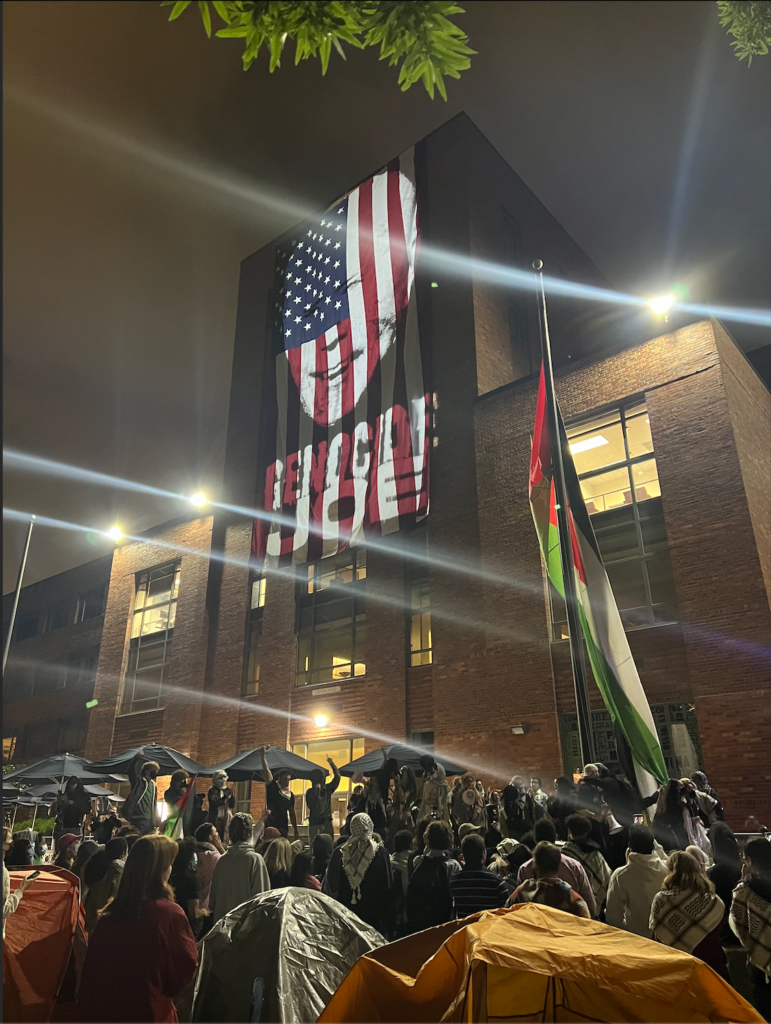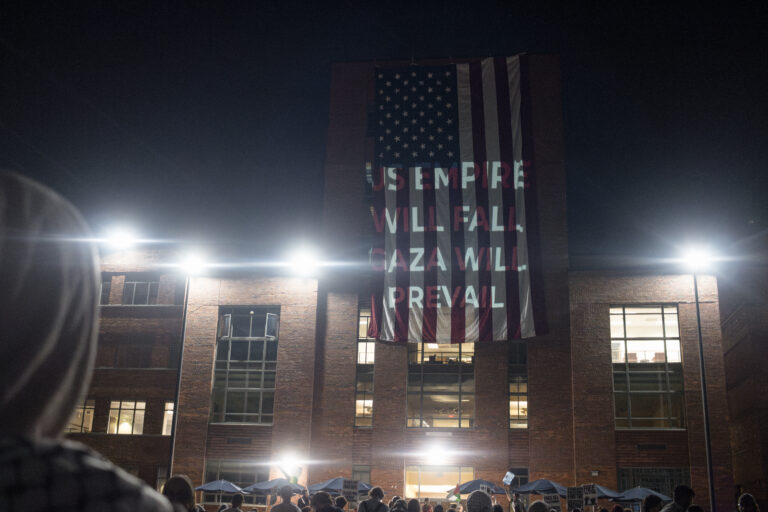Cover photo by Taytum Wymer
By Inshara Ali
“It’s a projection,” says a protester with Students for Justice in Palestine (SJP), a student-led solidarity movement for Palestinian liberation. “We have not touched private property. We have not touched this building.”
On October 24, 2023, a crowd is forming in GW’s Kogan Plaza. In simple white text, cast 40 feet high across Gelman library from a small classroom projector propped up on a coffee table, are the words:
“FREE PALESTINE FROM THE RIVER TO THE SEA”
Four SJP demonstrators sit cross-legged across from the library donning head-to-toe black clothing and face masks. Positioned in front of them are two GWPD officers and a university official, who have arrived nearly an hour after the demonstration’s start. The message switches again.
“GLORY TO OUR MARTYRS”
As the protesters and GW officers exchange verbal blows the crowd begins to fill the university plaza. Some onlookers scoff at the demonstrators while others condemn the attempts to shut the demonstration down. Students hand face masks to one another and cover their faces from the flash photography. The projection changes.
“END THE SIEGE ON GAZA”
Two GW police officers, hugging their tactical vests, hover over the four activists organizing the demonstration.
“You have to leave,” one of the officers repeats to the protesters.
On October 7, Hamas, the Palestinian militant group and de-facto leader of Gaza, led a series of attacks on an Israeli music festival that led to the official declaration of war between Israel and Hamas. In the following days the world saw a myriad of Gazan civilians displaced from their homes as the Palestinian death toll reached over 2,000—now over 38,000.
On October 10, SJP GW hosted the controversial “Vigil for the Martyrs of Palestine.” While the organizers cited “martyrs” as a term of respect referring to all Palestinian lives lost in the war others criticized the label as an antisemitic glorification of Hamas’ military actions.
The morning after the vigil, GW President Ellen Granberg released a statement titled, “Thoughts on Recent Campus Events and the War in Israel and Gaza.” In it, she reiterated her condemnation of the attack on Israel on October 7.
“I not only condemn terrorism, but I also abhor the celebration of terrorism and attempts to perpetuate rhetoric or imagery that glorifies acts of violence,” Granberg wrote. “Such messages do not speak on behalf of me, our administrators, or GW.”
Though it was never explicitly referenced in Granberg’s statement many students and SJP took this as a false equivalence between the vigil and terrorism, as well as a condemnation of their movement supporting justice for the Palestinian people. They responded with the Gelman Library projections later that month.
Projection bombing, also known as guerrilla projection, has been a popular tool in grassroots activist circles to protest artistically while potentially avoiding legal trouble. Projection bombing can involve high-lumen projectors that can cost upwards of $10,000, but many online circles show protesters how to use run-of-the-mill classroom projectors to have similar effects.
By staging these light invasions activists hope to spread their messages in areas where they are not otherwise accepted. In these acts of protest, organizations combine purposeful artistry and staunch political messages. Guerrilla projections have a long history in Washington, D.C. as a form of protest.
Over the course of former President Donald Trump’s term, activist Robin Bell projected nearly 60 messages on the building that was previously the Trump International Hotel. Some of his most famous demonstrations projected the words “A TRAITOR SLEEPS IN THE WHITE HOUSE.” and “IMPEACH.” across the former president’s property.
“You know, I think projection is unique in its ability,” Bell said in an interview. “It’s just one tool in the pursuit of public discourse.”
While some of Bell and his staff’s projections have been met with arrests and criminal charges some legal scholars argue projection demonstrations are largely protected. In an op-ed in The Washington Post, lawyer and contributor Eugene Volokh argued that projection demonstrations do not violate criminal trespass laws, as long as the projections don’t interfere with the business or constitute a “nuisance.”
Though most of his demonstrations were completed without legal intervention, Bell cites several occasions that escalated as the validity of their demonstrations were in question.
“We had times where we actually had to have police get security guards to not be physical with us. You know, they were assaulting us. It’s tricky,” said Bell.
Members of SJP consulted legal briefings and political organizations with guerrilla projection experience, who led them to the conclusion that there was nothing in GW’s Student Conduct policies or city law that prohibited projections. So, they began organizing an action to project a series of phrases calling out GW’s actions following October 7th, including calls to “divest from Zionism” and reiterating the term martyrs.
“We wanted to respond very specifically to the condemnations the University put out in regards to condemning our vigil for Palestinians as a celebration of terrorism,” said a member of SJP involved in the action, who chose to remain anonymous. “So, we decided to do a projection action very specifically because we wanted it to be in line with Student Conduct policies as well as D.C. law.”
In the first hour of demonstration protestors were approached by Lieutenant Sean Brown, who affirmed that they were not in violation of university policy or city law. In the following hours Dean of Students Colette Coleman made a call to GWPD demanding the projection be taken down. Lieutenant Brown, alongside Assistant Dean Brian Joyce, informed the SJP members that they were being asked to take down the projections. After about 15 minutes of dispute between the demonstrators and the officials, the protest ended. As SJP members took down their projection and collected their things, a member chanted, “Free Palestine” repeatedly.
The crowd began to split into two segments. One side echoing the chants of the SJP member. The other side began to sing a Jewish prayer. Just as the rest of the world after October 7th, the two groups were utterly divided, each attempting to drown out the other’s calls.
Outrage on social media exploded, citing several of the phrases used during the protest as antisemitic. Many called on GW to expel the students involved while politicians such as Senator Josh Hawley (R-MO) and Senate Minority Leader Mitch McConnell (R-KY) openly condemned the action and reiterated their support for Israel.
“Last night, at George Washington University here in the nation’s capital, student activists projected antisemitic messages on the side of a campus building named for a pair of Jewish benefactors,” McConnell said in his speech on the Senate floor. “They issued a call to free Palestine from the river to the sea. For anyone unfamiliar with Israel’s geography, that is a call for the destruction of the Jewish state.”
Soon after the demonstration, several SJP members involved were notified that they were being charged by the Student Rights & Responsibilities for violations of the non-compliance policy and building use regulation specifically stipulated for the Gelman library. In November of 2023, SJP was suspended by the university for 90 days and was barred from posting communications on campus until after the academic year ended.
“Free speech is something that’s not a blanket policy,” said the anonymous SJP member. “Free speech is something that is doled out to very specific groups and is repressed amongst very specific groups.”
When the newly formed DMV coalition of Students for Justice in Palestine began encamping on GW’s campus to protest the university’s ties to Israel and the war on Gaza, many of the protesters involved in October’s projections began to set up their tents. In the following days, members of Congress, including Senator Hawley and Representative Lauren Boebert (R-CO), visited the encampment to condemn the protest.
On May 2, the eighth day of the encampment, protesters hoisted a Palestinian flag on the flagpole in University Yard. Minutes later, GWPD officers removed the flag as protesters booed and chanted, “IOF, KKK, GWPD, they’re all the same!”
IOF, short for Israeli Occupation Forces, is a name given by anti-Israel advocates to the Israeli Defense Forces (IDF) to criticize the occupation of Palestinian territories and the treatment of Palestinians by the IDF.
Within the hour the flag was back up. In the following days, Palestinian flags were raised by protesters and removed by GWPD repeatedly. President Granberg sent out a message to the GW community that night, condemning the “aggressive act of lawlessness.”
On May 3, day nine of the encampment, a large American flag—reportedly approved by the university administration—was hung off of the roof of Lisner Hall, facing the encampment as the Palestinian flag flew high to the right.
“This is literally the shit we’re protesting against,” one protester camping out in University Yard said, choosing to remain anonymous due to doxxing fears.
The protesters and the university were seemingly at an impasse. Every time GWPD attempted to take the Palestinian flag down, protesters seemed to find a way to re-hoist it. But the American flag, covering almost all five stories of Lisner Hall, cast a daunting shadow on the protesters.
At 10 that night, the encampment shined bright. Projected from the outskirts of the encampment onto the American flag was an image of President Joe Biden and the words “GENOCIDE JOE”.

A protester chanted through a megaphone to the growing crowd, “Who got the flag up?”
“We got the flag up!” the crowd responded, as GWPD officers watched from the sides.
Guerrilla projections are inextricably linked to questions of free speech, property rights, and political messaging—and this case was no different.
“We’re really proud of the fact that our images can be the visualization of a bigger issue that’s hard to visualize,” said Bell.
By utilizing the very symbol meant to discourage them, the DMV SJP was able to protest both GW’s actions and American foreign policy—recentering the core message of the encampment. Months after the removal of the encampment from GW’s campus, the action remains a symbol of the movement’s power, ideology, and innovation.
“These issues, time and time again, go very unaddressed by the school and unaddressed by this university. And that’s not just in the aftermath of October 7, right? This is a pattern that we’ve seen for years and years and years,” said the anonymous SJP member. “Our biggest purpose and goal in doing this action was simply to ensure that Palestinian voices, Arab and Muslim voices, can’t be ignored by this university anymore.”




Very good recount of events, gives a clear picture of the timeline.